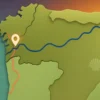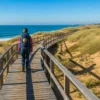A Harmonious Blend of History, Nature, and Cultural Charm
Walking the Portuguese Coastal Way from Esposende to Viana do Castelo is an immersive journey through the essence of northern Portugal. With 24 kilometers of coastal paths, forest trails, and traditional villages, this stage is a beautiful mix of sea views, historical detours, and countryside calm.
Whether you’re walking to reflect, explore, or simply appreciate the landscapes, this stage offers a gentle challenge and rewarding experiences in equal measure.
📌 At-a-Glance Infographic
Stage: Esposende → Viana do Castelo
Distance: 24 km (15 miles)
Estimated Time: 5 to 6 hours
Difficulty: Moderate
Landscape: Coastal paths, rural villages, forests, historical landmarks
Main Stops: Castro de São Lourenço, Marinhas, Chafé, Viana do Castelo
What to Expect from Stage 3 of the Portuguese Coastal Way
This stage marks a transition from the oceanfront into Portugal’s verdant interior. Starting at sea level in Esposende, you’ll gradually ascend through rolling terrain and ancient paths.
Right from the beginning, the Portuguese Coastal Way shows its diversity – from Atlantic breezes to leafy forests and cobbled lanes through local hamlets. If you’re looking for a stage that combines natural beauty with cultural depth, this is it.
Route Breakdown and Highlights
1. Departure from Esposende
The day starts with the sound of the sea and panoramic Atlantic views. The flat terrain here makes it a gentle warm-up.
2. Castro de São Lourenço: Optional Detour for History Lovers
A short uphill deviation takes you to this archaeological site, offering:
- Ruins of a prehistoric Celtic settlement
- Wide views over the ocean and valleys
- A glimpse into Portugal’s ancient past
3. Marinhas: Rest and Local Culture
A charming stop along the way:
- Traditional Portuguese homes
- The Church of Santa Marinha
- A good place for coffee at Café Pinguim
4. Chafé: Tranquility Before the City
Before arriving in Viana, pass through this quiet rural village:
- Visit the Church of São Tiago
- Enjoy the peaceful countryside atmosphere
5. Arrival in Viana do Castelo: Culture and Architecture
Finish your stage in a city rich with history:
- Basilica of Santa Luzia, overlooking the city and Lima River
- Republic Square and Costume Museum in the medieval center
- Excellent food, views, and energy
Checklist: What to Bring on Stage 3
Prepare for changing scenery and weather:
- Waterproof Jacket: essential in case of sudden rain
- Warm Layer: coastal air can be brisk, especially in the morning
- Snacks and Water: especially for less developed rural sections
- Map or GPS: helpful in the forested and village transitions
- Camera or Smartphone: the views near Santa Luzia are unforgettable
Accommodation and Dining Suggestions
Where to Stay in Viana do Castelo
- Albergue de Peregrinos Sao Joao dos Caminhos: basic, pilgrim-friendly
- Hotel Fábrica do Chocolate: for a unique themed experience
Where to Eat
- Belinho: Lampião Café, good for a light snack
- Viana do Castelo: Tasquinha da Linda, popular for seafood and local dishes
FAQ: What Pilgrims Want to Know
Is Stage 3 physically demanding?
It’s moderately challenging due to distance and a few gradual ascents, but very doable for those with average fitness.
Is the path well-marked?
Yes, but rural segments and forest areas may benefit from a GPS backup.
When is the best time to walk this route?
Late spring and early autumn (May and September) offer the best weather and fewer crowds.
Insights and Curiosities
- Castro de São Lourenço dates back to pre-Roman times and was used for centuries as a hillfort settlement.
- The Basilica of Santa Luzia was inspired by the Sacré-Cœur in Paris and is one of the most iconic viewpoints in Portugal.
Final Words: A Stage That Stays With You
From coastal serenity to urban heritage, this part of the Portuguese Coastal Way will linger in your memory long after you arrive in Viana do Castelo. It’s a day of contrasts – from ancient ruins to modern architecture, from forest trails to seafood tables.
Ready for more? Don’t miss Stage 4 – Viana do Castelo to A Guarda, where your pilgrimage continues across the border into Spain.
Or join our WhatsApp community for daily tips, shared stories, and real-time support along the Portuguese Camino.






